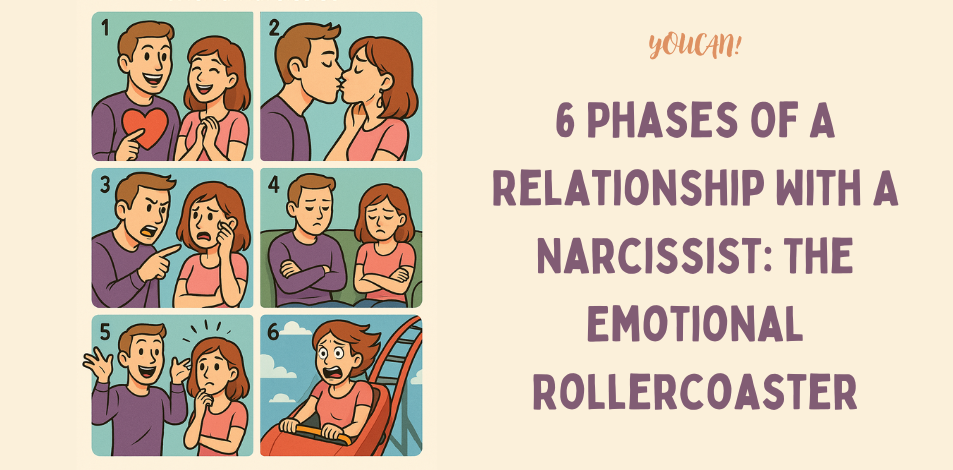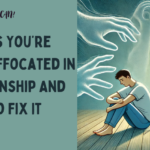
In a relationship with a narcissist, you may experience emotional rollercoaster rides, with each stage presenting new challenges and realizations. These stages of a narcissistic relationship can make you question your self-worth. Understanding these stages can help you navigate the ups and downs of a narcissistic relationship more effectively.
Key Points
- Narcissists may manipulate through observation and charm, creating a false sense of connectedness.
- These relationships go through distinct phases, often gradually ending, and can be painful.
- Understanding these phases can aid healing and setting boundaries.
Relationships with individuals with Narcissistic Personality Disorder (NPD) involve a series of dynamics that can be complex and difficult to navigate, often leaving lasting emotional scars ranging from emotional pain to lasting trauma.
Through my observations from working with and interacting with numerous couples, I’ve identified a series of stages that characterize a narcissist’s approach to relationships.
These stages reveal a pattern of manipulation, emotional control, and ultimately emotional and physical abandonment, which can negatively impact their partners.
Understanding these stages helps recognize the dynamics at play and, for those who find themselves involved in such relationships, helps them navigate their path to recovery after being under the influence of drugs and inextricably linked to a person who has shown little interest in them.
6 Stages of a Relationship with a Narcissist
- Observation
The narcissist begins this stage by meticulously studying their target’s behavior, routines, interests, and vulnerabilities. The narcissist aims to gather valuable information that will enable them to effectively manage the situation.
The narcissist subtly displays their charm and attractiveness without direct interaction, captivating the target and luring them into the relationship. For them, choosing the right partner is crucial.
- Approach
In this stage, the narcissist connects with the target and begins to shower them with love, showering them with excessive affection, attention, and flattery, accompanied by periods of indifference.
The euphoria that results from this tactic makes the target vulnerable and more susceptible to the narcissist’s charm.
At some point, the narcissist appears deeply immersed in the relationship, accelerating its intensity and fostering a false sense of a strong, almost permanent bond.
- Show-Off
Here, the narcissist carefully creates an idealized persona, highlighting their accomplishments, relationships, and material possessions to captivate and charm the target.
They create an aura of success and attractiveness, ensuring their target sees them as exceptional and worthy of admiration. The narcissist aims to charm and impress their target, making them feel special and privileged in their company. During this stage, they create a strong emotional bond by portraying themselves as ideal partners and even mimicking their target’s interests.
The narcissist may adapt his or her personality to reflect the target’s values, strengthening the emotional bond and cementing their trust in the relationship.
- Need
This is arguably the longest and most emotionally draining stage, where the narcissist exploits the target’s empathy and compassion by focusing on their vulnerability or need, and the trust they have built. Narcissists engineer crises and tensions to maintain emotional control and dependency.
As the target prioritizes the narcissist’s needs and ignores their own, the erosion of their self-esteem and personal boundaries may become increasingly apparent to the narcissist and others, but not to the partner, who may have formed a traumatic bond during this stage.
- Abandonment
Contrary to popular belief, the abandonment stage is not always sudden. This stage can develop gradually and be long and painful. The narcissist may plan their exit strategy, but they still need the relationship for various reasons that they conceal.
Narcissists begin the process of withdrawal, depriving the target of the most important aspects of emotional intimacy and support. This stage is filled with psychological manipulation, accusations, devaluation, abuse, and a lack of commitment, loyalty, and accountability.
The partner is left alone, but they may still be under the illusion created by the narcissist that they are at fault and deserve “punishment.” It can be extremely difficult for the partner to realize what narcissism entails, as this awareness can be threatening to the narcissist. Recognizing narcissistic abuse is often the beginning of a partner’s fall from grace and the end of the bond.
- Leaving
This stage is often overlooked, but it is crucial in understanding the narcissist’s motivations. As the narcissist prepares to end the relationship and arranges their departure, they may make a last-ditch attempt to regain control and preserve their self-image. They may apologize, express remorse, or manipulate the target into believing they possess good qualities to absolve themselves of any guilt and preserve their reputation.
Regardless of the partner’s reaction, the narcissist ultimately creates a narrative that portrays themselves as the victim. They will express resentment toward their ex-partner, speak badly of them in front of others, and make false accusations in public.
They may claim that their partner made their life difficult or took away something that belonged to them, such as children, property, or social status.
There are some couples who live together for a period of time and pretend to be married, but as soon as the narcissist “leaves,” even if they still live in the same house, the marriage ends.
As a trauma specialist, I can’t conclude without addressing the trauma associated with a relationship with a narcissist. Typically, a partner is chosen for their positive qualities, which the narcissist seeks to exploit. Feeling valued leads the target to lower their guard and build trust in their partner.
This makes them easy prey for manipulation tactics such as psychological manipulation, given the trust and potentially traumatic bond established in the name of love. For this reason, the abandonment and leaving phases are so devastating.
Slow abandonment can keep a partner in a state of uncertainty, activating their stress responses and altering their nervous system’s day-to-day functioning.
These gradual and ongoing emotional ups and downs are often referred to as complex trauma, or slow-onset trauma, where the struggle to survive is fraught with challenges such as self-doubt, feelings of worthlessness, shame, confusion, fear, and instability.
As the narcissist erodes the qualities that initially attracted them to their partner, the target may experience low self-esteem and a sense of debility.
This erosion of personal identity can leave the partner feeling confused and helpless, questioning their ability to withstand the ongoing emotional abuse.
Once you recognize these warning signs and understand the narcissist’s true intentions behind their actions, you can begin the healing process, rebuild your damaged sense of self, and reclaim yourself and your potential.
By identifying these stages, you can take steps to protect your emotional well-being and set boundaries to prevent further harm.




